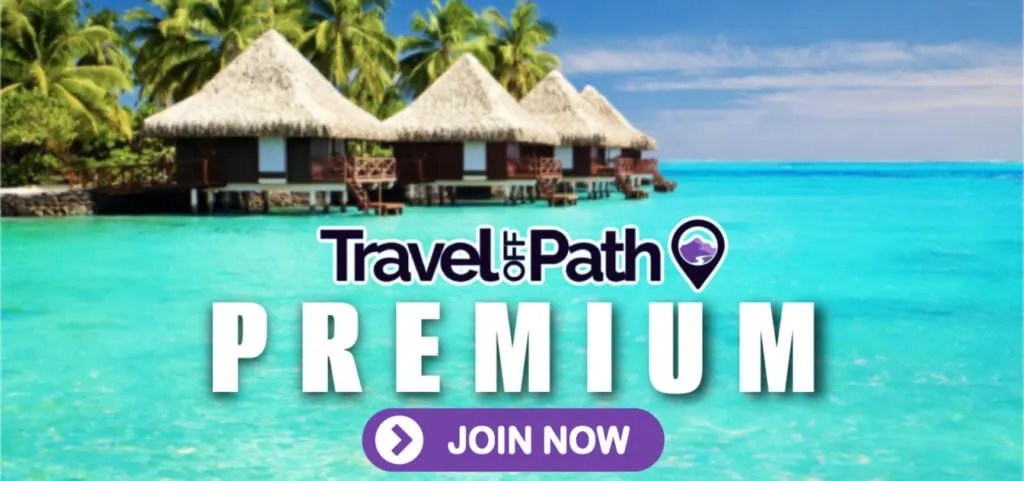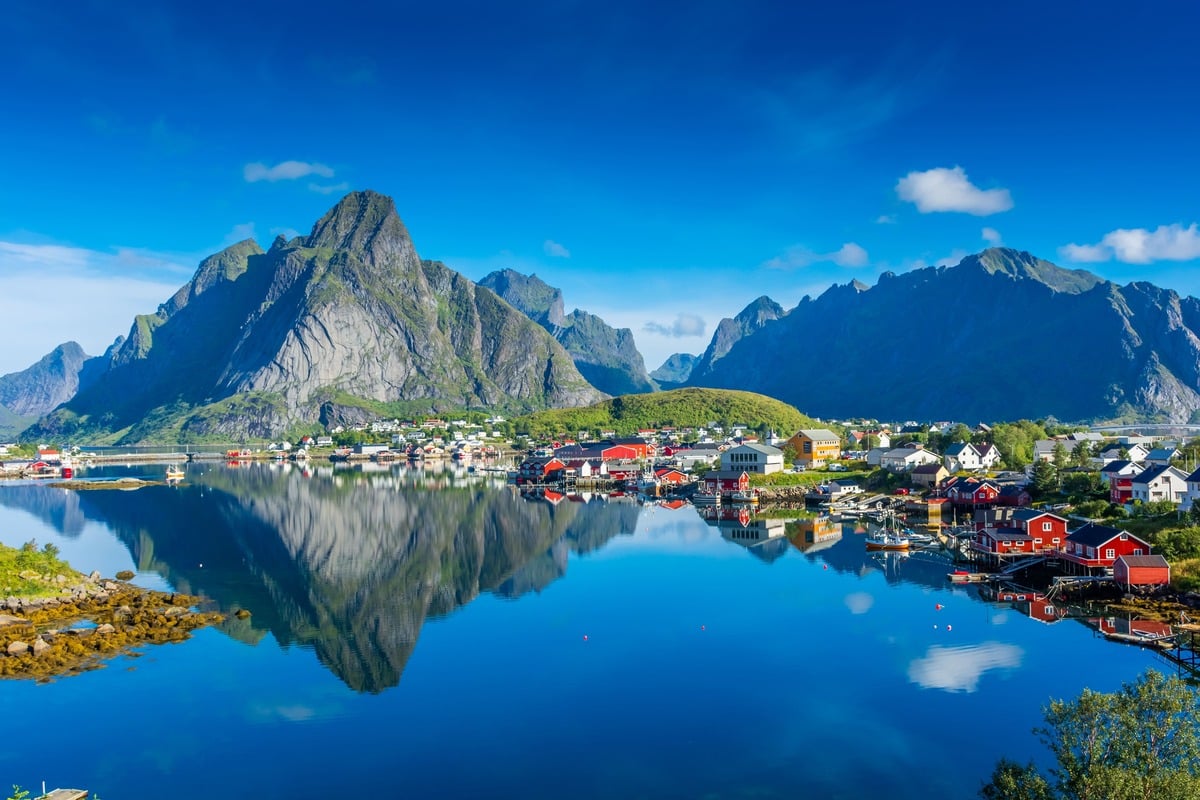Share the article
Last updated
Does the thought of scorching 40°C heat, raging forest fires that occasionally lead to the evacuation of holiday resorts and unsustainable mass tourism put you off visiting Southern Europe this summer?
You’re not the only one:
A growing number of travelers are actively avoiding Spain, France, Italy and the like as visitor numbers and temperatures rise beyond manageable levels.
But if you still fancy experiencing some culture while enjoying cooler weather and beating the crowds, we have an alternative for you.
Just off the coast of Northern Norway is the Lofoten offers unparalleled natural landscapes, Scandinavian heritage and, most importantly, milder weather:

What exactly is Lofoten?
Norway’s most famous archipelago, the Lofoten Islands, is a collection of seven main islands connected by man-made bridges and narrow nature-made crossings, like a once-intact peninsula divided into smaller pieces.
It’s quite remote and you’re unlikely to see crowds of tourists disembarking here, even at the height of the boating season, making Lofoten particularly attractive to die-hard tourists. travelers who want to get off the beaten track and immerse themselves in the local culture.
Norway as a whole is already a great destination escape the hustle and bustle of Europe’s major cities, as it is largely rural and crisscrossed by towering highlands and winding fjords, but these islands give idyllic a completely different meaning:


Summers are always much cooler here
Lofoten has unique geological features, characterized by rugged mountain peaks, sheltered bays and undisturbed Arctic nature.
You read that right: since it is part of the Nordland county in Norway, it lies above the Arctic Circle.
It’s never too hot in Lofoten, even at the height of summer, when other destinations in Southern Norway can easily reach temperatures of 86°F, and you can expect quite mild temperatures ranging between 73.4°F during the day and 57.2°F at nightfall.
As we like to say: shorts off when the sun is out, long-sleeved shirts – and maybe a cozy, lightweight summer cardigan – after sunset: trust us, you’re going to spend a lot of time outside in Lofoten, and if you love the outdoors, you’ve definitely come to the right place:


What makes Lofoten so special?
This is a natural oasis of crystal clear lagoons and scenic mountain ranges and it is beautiful whatever the season, but we will argue that summer is probably the best time to visit as the seas around Lofoten are not frozen, snow is limited to some mountain peaks and there are plenty of hours of daylight are.
Whether it’s an evening kayaking trip along the Svolvær coast, as the sun sets over the mountains, or a guided climb of the emblematic Svolværgeita, there are countless activities to keep the adventurer in you entertained over a long weekend, if not an entire week.
To give you a bit of a head start, these are the following 5 of the most unique tours in Lofoten and their prices:


Perfect for visiting smaller islands only accessible by boat and secluded beaches.
Ideal for those who want to get active and experience the wild Arctic nature up close
The easiest way to visit the island of Værøy and its sleepy fishing villages on a day trip
An open boat trip across one of Norway’s most breathtaking fjords – what more could you want?
Your best chance to spot the elusive lights in a northern location while it’s still not a frigid winter
*This tour is only offered from the end of August when aurora activity in the Arctic resumes


It has some great free activities
That being said, nature in Norway is free to discoverand everyone has the right to wander around freely:
There are beautiful places around Lofoten, including pristine beaches with shiny white sand, such as Haukland, on the island of Vestvågøy, chosen The best of Europe this year Through Lonely planetand Punn Beach in Værøynd.
Just don’t jump into the water expecting it to be as warm as the Mediterranean, otherwise you might be in for an unpleasant surprise.


For enthusiastic hikers, Tjeldbergtind is a popular mountain to climb.
It lasts about two hours and offers priceless views of the snow-capped peaks of the archipelago and the several small islands scattered along the bay.
A path of 2 hours up and 2 hours down, at the eerie sounding Devil’s Gate (Djevelporten) you will find the Norwegian the second most iconic hanging rock located between two cliffs, after the one in Kjeragbolten:
Visitors often pose for photos on top, and although no accidents were recorded, you obviously do so at your own risk; the most fascinating part is the sweeping panorama of the rock formations bordered by azure water in the distance.


Near Moskenes, the Reinebringen walk is another must-do.
It rises to 448 meters above sea level and it’s best enjoyed between May and September, when it’s not super cold for climbing and the sun is relatively warm and pleasant.
There is certainly no shortage of nature-made wonders to admire around Lofoten, and the hiking options are numerous, but if you’re looking for something man-made and truly unique, then the hike from Nusfjord to Nesland should be at the top of your list. should be on the list.
Nusfjord is one of the oldest villages in Lofotenand if you plan to stay overnight to complete the hike at a leisurely pace, consider booking a stay in a fjord-view cottage on beautiful Nusfjord Arctic Resortfrom $282.59 per night this summer.


The path to the equally picturesque village of Nesland can be steep and strenuous in parts, but the completely undisturbed Arctic nature makes it all worth it.
Does Lofoten have anything to offer culturally?
You’ve probably come all the way to Northern Europe experience something of the Old WorldScandinavian charm, and you’ll be happy to know that one of the most beautiful towns in all of Norway, picture-postcard Reine, is located on a small bay on the island of Moskenesøya.
With its vibrant red, wooded houses, Reine has to be (probably) the most photographed place in the archipelago, but the largest city, often called ‘the world’s smallest big city’, is the surprisingly lively Svolvær:


As beautiful as the other villages are, this compact regional ‘capital’ is the best place to stay in Lofoten, with its World War II memorial museum, art galleries, casual seafood restaurants and well-equipped tourist facilities.
If you are looking for an authentic restaurant to taste Norwegian food, they are there Doing have the best smoked salmon in the world – make sure you add Børsen Spiseri, in the heart of Svolvær, to your list.
Norway is known to have some of the highest prices in Europe, and accommodation is no exception there are still some good deals out there can be found around Lofoten, especially in Svolvær, where there are more offers to choose from.


For example, an overnight stay in a privately managed property Kule gule house boarding house will cost you just $89 per night on widely available dates this summer, while a standard double room in the centrally located, basic amenities Marina hotel costs an acceptable $143 to book.
They would be on the cheaper side, but of course room prices can be high, a lot of higher once you start looking for a little more comfort and perhaps a continental breakfast included.
What we’re trying to say is that Lofoten is definitely not the cheapest summer adventure to embark on once you start adding secondary expenses like car rental. Trust us, you’ll need one to get around unless you feel like walking long distances or taking ferries. -but it is worth a try.


✈️Join our Travel Off Path community forum: Where travelers come together, ask questions, share experiences and even find like-minded travel companions!
SUBSCRIBE TO OUR LATEST POSTS
Enter your email address to subscribe to the latest Travel Off Path breaking travel news, delivered straight to your inbox.
This article originally appeared on TravelOffPath.com
The opinions expressed here are solely those of the author, and not those of any bank, credit card issuer, hotel, airline or other entity. This content has not been reviewed, approved, or otherwise endorsed by any of the entities included in the post.





